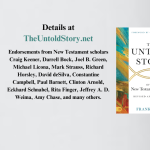Sermon Outline for Third Sunday in Advent: God With Us INTRODUCTION When John describes the incarnation, he uses an image drawn from the Pentateuch, saying that the “Word became flesh and ‘pitched His tent’ among us” (John 1:14). The phrase “pitch his tent” can also be translated as “tabernacled,” and refers to the sanctuary that Israel built when they came from Egypt. Jesus is the fulfillment of this sanctuary, the “Holy Place” where God dwells. THE TEXT “Then the Lord... Read more
















